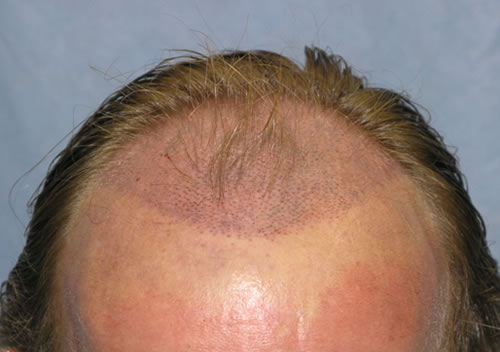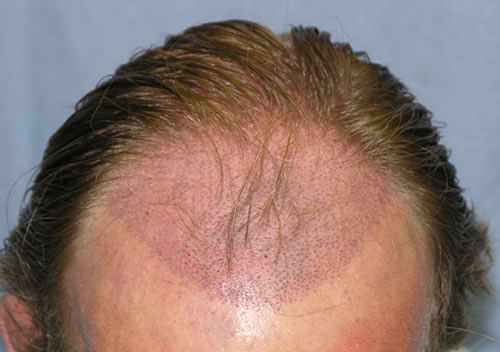What is a Recipient Site?
When performing a hair transplant, the surgeon creates hundreds to thousands of tiny incisions, called recipient sites, in the balding areas of the scalp where harvested follicular unit grafts are to be placed. The pattern of recipient sites, and how they are created, has a major impact on the outcome of the hair transplant.
How Are Recipient Sites Created?
To create the recipient sites, we use a variety of instruments depending on the clinical situation. In all hair transplants, the goal during the procedure is to create a snug fit between the follicular unit and the skin surrounding the graft. This will maximize oxygenation of the grafts, promote healing, and increase graft survival. Tiny recipient sites also ensure that there will be no visible scarring, pitting or other surface irregularities as a result of the hair restoration procedure.
We use fine hypodermic needles or a series of custom-made, ultra-fine blades to create the hair transplant recipient sites. The blades range in diameter from 0.6mm (for single-hair follicular unit grafts) to 0.9mm (for 4-hair follicular units).
The Art of Recipient Site Creation
Before site creation begins, the different size follicular units are fitted to specific site sizes to determine exactly the best size instrument to use for each graft. By custom fitting the sites to the grafts, healing is facilitated and our patients are able to return to showering and gentle shampooing the day following the hair restoration.
At Bernstein Medical, the recipient sites in all of our hair transplant procedures are made using lateral slits (also called coronal or horizontal slits). Recipient sites created using lateral slits give the hair transplant surgeon the highest degree of control over the direction and angle in which the transplanted hairs will ultimately grow.
Follicular units placed in lateral slits will provide more coverage than those placed in vertical slits, as the hair follicles tend to fan out over the surface of the scalp rather than lying on top of one another. Lateral slits also allow the hair transplant surgeon to angle the follicular unit grafts more acutely and follow the orientation of the patient’s original hair to match the way it grows in nature. This is particularly important at the temples, in the crown, sideburn areas, and in eyebrow restoration.
Controlling the depth of incision is also critical in making recipient sites, as limited depth incisions minimize injury to the deeper blood vessels in the scalp, allow grafts to be placed more closely together, decrease tissue swelling after hair transplant surgery, and facilitate healing.
Recipient Sites in a Hair Transplant

The photos above were taken during the hair transplant procedure just after the recipient sites were made and just prior to the insertion of the follicular unit grafts. The redness faded quickly over the course of the week.
Results of the Hair Transplant

The above patient had a Norwood Class 4A pattern of hair loss. A total of 3,511 grafts were used in two hair transplants spaced a year apart. The hair restoration procedures (2,002 grafts and 1,509 grafts) consisted entirely of microscopically dissected follicular units. See the hair transplant photo journal for a full review of the hair transplant procedure.
The density of recipient sites (the number of sites per area) determines how close together the follicular grafts are placed. The spacing of recipient sites depends upon a number of factors including:
- Desired graft density for the hair restoration
- Location on the scalp (grafts are generally placed closer together towards the front of the scalp and the forelock area and spaced further apart towards the crown)
- Size of area to be covered
- Total donor supply
- Ability to safely harvest a specific number of grafts in one hair transplant session
- Size of the individual follicular units (smaller follicular units can be placed into smaller recipient sites and smaller recipient sites can be placed closer together)
- Popping and other local factors that limit the very close placement of grafts during the hair restoration procedure
- The ability of the scalp to support a specific graft density (sun damage, smoking, and long standing baldness are factors that limit the close placement of grafts)
Although there is chat about “ultra-dense packing” on the internet, the very close placement of grafts must be performed in the appropriate patient. Dense packing allows the physician to accomplish the hair restoration as quickly as possible. However, as with any technique pushed to its limit, dense packing taken to the extreme carries risks that include poor perfusion of grafts (due to a compromised blood supply) and increased popping that can lead to graft desiccation (drying out of grafts) and crush injury from their re-insertion. These factors can lead to poor growth and a sub-optimal cosmetic result. It is always important to balance the desire to finish the restoration quickly with the requirement to use techniques that will maximize growth. In our opinion, the goal of achieving maximum growth after your hair transplants should never be compromised in order to achieve short-term goals.
Below is a patient with frontal balding who had one session of follicular unit transplantation (FUT). The recipient sites were made using lateral slits. Note that at 36 grafts per cm2 there is literally no space between these sites for additional grafts. The patient had a significant proportion of 3- and 4-hair follicular units (43% of the follicular units contained 3- or 4-hairs) limiting how small each site can be. In our practice, we do not divide follicular units for the sake of increasing graft numbers or increasing site density. Keeping follicular units intact will maximize the appearance of fullness and ensure that the restoration looks completely natural.


Robotic Recipient Site Creation
In recipient site creation during robotic hair transplant procedures, the ARTAS Robotic Hair Transplant System uses its image-guided technology to avoid hairs of a certain diameter specified by the doctor. The robot creates sites at a minimum distance from hairs of this diameter and will do so randomly throughout the areas where the hair is finer or the scalp is bald. With this important feature, the new distribution of sites can be made to complement the distribution of existing hair.
In recipient site creation during robotic hair transplant procedures, the ARTAS Robotic Hair Transplant System automatically uses its image-guided technology to avoid hairs of a certain diameter specified by the doctor. The robot creates sites at a minimum distance from hairs of this diameter and will do so randomly throughout the areas where the hair is finer or the scalp is bald. With this important feature, the new distribution of sites can be made to complement the distribution of any existing hair.
Video of Robotic Recipient Site Creation




